Life Cycle of a Plant

Educator Resources
Life Cycle of a Plant
Everything that lives on earth has a life cycle. Life has a beginning point, growth, reproduction, and an end of life. All plants have a life cycle and this cycle is very important to agriculture. Because a major source of our food is from plants, we can classify them by their life cycle. Crops can be sorted into annuals, biennials and perennials. But before we look into the classification of some agricultural crops, let’s first take a look at the plant life cycle.
Where it all Begins
Plants start their lives as tiny seeds. Seeds contain a plant with leaves, stem and roots. The first step a seed takes on its path is germination. Germination is when the plant within the seed begins to grow with the help of water, soil and sun. As the process continues, the plant develops stems and roots. Stems push up toward the light. Roots grow down into the soil. Now, leaves begin to grow. Leaves unfold, take in sunlight and produce food through photosynthesis. The plant then begins to develop flowers. Many plants produce flowers that are important in making seeds. The flowers are then pollinated. Flowers are pollinated when pollen from the stamen moves onto the pistil. Seeds and fruit are produced.
Agriculture and the Plant Life Cycle
Plants that are grown for our food and fiber can be classified by their life cycle. This refers to how long it takes the plant to complete its life cycle. Plants can be classified as annuals, biennials and perennials.
Annuals- Annuals are plants with a life cycle that lasts one year. Most annual plants are planted as seeds in the spring, bloom in the summer and then die off in the fall. Annuals will not grow the next year unless they are replanted as seeds the following spring.
Biennials- Biennials are plants with life cycles that take two years to complete. A biennial will be planted in the spring and will grow its roots, stem and leaves during the first year. The plant will then lay vegetative in the summer and dormant in the fall and winter. It will flower the second summer, and produce seeds before dying off during the fall season of its second year. Biennials require the period of being dormant, which is caused by cold temperatures.
Perennials- Perennials are plants with a life cycle that lasts more than two years. The entire plant does not die off in the fall. It will persist through the fall and winter seasons and will regrow from the same root system the following spring season.
Classification of Crops
A major source of our food is from plants. Take a look at the classification of some of these plants based on their life cycle; Annuals, biennials and perennials.
The plant life cycle is important to agriculture. A lot goes into the food we eat. Farmers are plant cycle professionals, tending to their planting and growth, so we can enjoy the fruit or vegetable it produces. Farmers know the life cycle of every plant they grow and harvest. They understand when to plant the seeds, how long it will take to grow, and how best to nurture the crop during the life cycle.
Download a PDF version of the infographic.


Sources: Coolkidfacts.com, natgeokids.com, PennState Plant Life Cycles, The Fact Factor-Classification of Crops.